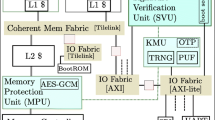Abstract
RISC-V open-hardware designs are emerging in cyber-physical systems and security-critical embedded platforms. Among them, OpenTitan emerged as an open-source silicon Root-of-Trust, which provides secure-boot and execution-integrity functionalities, exploiting its internal hardware accelerators. In this paper, we explore a novel exploitation of OpenTitan as a secure cryptographic accelerator. To this purpose, we designed TitanSSL, a secure software stack that offloads cryptographic tasks to OpenTitan, and we study the trade-offs between offloading overhead through the stack and the obtained computation speed-up. TitanSSL includes an OpenSSL backend, a Linux driver for communications, and an OpenTitan firmware. We executed TitanSSL on a cycle-accurate simulator of a RISC-V CVA6 application processor integrated with OpenTitan on the same System-on-Chip. We compared our implementation with a pure software version across different cryptographic payloads. Finally, we provide guidelines for the use of OpenTitan as a coprocessor in secure cyber-physical systems designs based on open-hardware architectures.
Access this chapter
Tax calculation will be finalised at checkout
Purchases are for personal use only
Similar content being viewed by others
References
Andrade, G., Lee, D., Kohlbrenner, D., Asanovic, K., Song, D.: Software-Based Off-Chip Memory Protection for RISC-V Trusted Execution Environments. UC Berkeley (2020)
Bach-Nutman, M.: Understanding the top 10 owasp vulnerabilities. arXiv preprint arXiv:2012.09960 (2020)
Cheang, K., Rasmussen, C., Lee, D., Kohlbrenner, D.W., Asanović, K., Seshia, S.A.: Verifying risc-v physical memory protection (2022)
Ciani, M., et al.: Cyber security aboard micro aerial vehicles: an opentitan-based visual communication use case. In: 2023 IEEE International Symposium on Circuits and Systems (ISCAS), pp. 1–5 (2023). https://doi.org/10.1109/ISCAS46773.2023.10181732
lowRISC CIC. Opentitan official documentation (2019). https://opentitan.org/book/doc/introduction.html
Costan, V., Devadas, S.: Intel sgx explained. Cryptology ePrint Archive, Paper 2016/086 (2016). https://eprint.iacr.org/2016/086
Davide Schiavone, P., et al.: Slow and steady wins the race? a comparison of ultra-low-power RISC-V cores for internet-of-things applications. In: 2017 27th International Symposium on Power and Timing Modeling, Optimization and Simulation (PATMOS), pp. 1–8 (2017). https://doi.org/10.1109/PATMOS.2017.8106976
Enumeration, C.W.: 2022 CWE top 25 most dangerous software weaknesses (2022). https://cwe.mitre.org/top25/archive/2022/2022_cwe_top25.html
Fadiheh, M.R., Stoffel, D., Barrett, C., Mitra, S., Kunz, W.: Processor hardware security vulnerabilities and their detection by unique program execution checking. In: 2019 Design, Automation and Test in Europe Conference and Exhibition, 2019, pp. 994–999 (2019). https://doi.org/10.23919/DATE.2019.8715004
Foundation, O.S.: Source code for the openssl software (1998). https://github.com/openssl/openssl
Gautschi, M., et al.: Near-threshold RISC-V core with DSP extensions for scalable IOT endpoint devices. IEEE Trans. Very Large Scale Integr. Syst. 25(10), 2700–2713 (2017). https://doi.org/10.1109/TVLSI.2017.2654506
Group, G.P.: Global platform client API documentation (2023). https://optee.readthedocs.io/en/stable/architecture/globalplatform_api.html#tee-client-api
Group, G.P.: Global platform official website (2023). https://globalplatform.org/
Joannou, A., et al.: Efficient tagged memory. In: 2017 IEEE International Conference on Computer Design (ICCD), pp. 641–648 (2017). https://doi.org/10.1109/ICCD.2017.112
Johnson, S., Rizzo, D., Ranganathan, P., McCune, J., Ho, R.: Titan: enabling a transparent silicon root of trust for cloud. In: Hot Chips: A Symposium on High Performance Chips, vol. 194 (2018)
Lee, D., Kohlbrenner, D., Shinde, S., Asanović, K., Song, D.: Keystone: an open framework for architecting trusted execution environments. In: Proceedings of the Fifteenth European Conference on Computer Systems (EuroSys 2020). Association for Computing Machinery, New York (2020).https://doi.org/10.1145/3342195.3387532
Lee, D., Kohlbrenner, D., Shinde, S., Song, D., Asanović, K.: Keystone: an open framework for architecting tees (2019)
Lu, T.: A survey on RISC-V security: hardware and architecture (2021)
Nasahl, P., Mangard, S.: Scramble-cfi: mitigating fault-induced control-flow attacks on opentitan (2023)
NXP. Edgelock secure enclave (2019). https://www.nxp.com/products/nxp-product-information/nxp-product-programs/edgelock-secure-enclave:EDGELOCK-SECURE-ENCLAVE
Parno, B., McCune, J.M., Perrig, A.: Roots of Trust, pp. 35–40. Springer, New York (2011). https://doi.org/10.1007/978-1-4614-1460-5_6
Pinto, S., Santos, N.: Demystifying arm trustzone: a comprehensive survey. ACM Comput. Surv. 51(6) (2020). https://doi.org/10.1145/3291047
Potter, B.: Microsoft SDL threat modelling tool. Netw. Secur. 2009(1), 15–18 (2009)
Schrammel, D., et al.: Donky: domain keys–efficient in-process isolation for RISC-V and x86. In: Proceedings of the 29th USENIX Conference on Security Symposium, pp. 1677–1694 (2020)
Weiser, S., Werner, M., Brasser, F., Malenko, M., Mangard, S., Sadeghi, A.R.: Timber-v: tag-isolated memory bringing fine-grained enclaves to risc-v
Zaruba, F., Benini, L.: The cost of application-class processing: energy and performance analysis of a Linux-ready 1.7-GHZ 64-bit RISC-V core in 22-nm FDSOI technology. IEEE Trans. Very Large Scale Integrat. Syst. 27(11), 2629–2640 (2019). https://doi.org/10.1109/TVLSI.2019.2926114
Author information
Authors and Affiliations
Corresponding author
Editor information
Editors and Affiliations
Rights and permissions
Copyright information
© 2024 The Author(s), under exclusive license to Springer Nature Switzerland AG
About this paper
Cite this paper
Musa, A. et al. (2024). TitanSSL: Towards Accelerating OpenSSL in a Full RISC-V Architecture Using OpenTitan Root-of-Trust. In: Ceccarelli, A., Trapp, M., Bondavalli, A., Bitsch, F. (eds) Computer Safety, Reliability, and Security. SAFECOMP 2024. Lecture Notes in Computer Science, vol 14988. Springer, Cham. https://doi.org/10.1007/978-3-031-68606-1_11
Download citation
DOI: https://doi.org/10.1007/978-3-031-68606-1_11
Published:
Publisher Name: Springer, Cham
Print ISBN: 978-3-031-68605-4
Online ISBN: 978-3-031-68606-1
eBook Packages: Computer ScienceComputer Science (R0)



